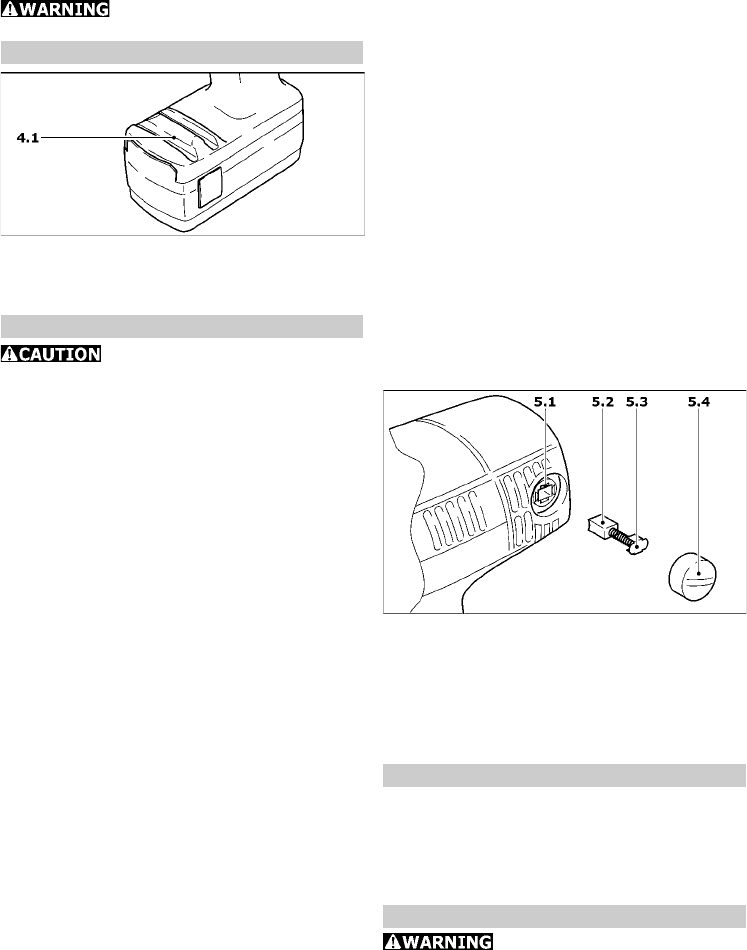
6
LED red – steady:
temperature of battery pack is outside
permissible limit.
It is essential that you read the
instructions in the Chapter „Maintenance - Care“.
Bit storage well
You can insert several bits or bit extensions into
the bit magazine (4.1) from the side.
The magnetic attachment allows you to pick up
screws and similar objects.
Maintenance and care
Pay attention to the following
instructions. Otherwise there is a risk of damage
to the tool, charger or battery pack.
• Repairs may only be performed by authorised
technicians. LC 45 charging device: Even after
disconnection from the mains, there is still a
high capacitor voltage on the power output
component on the inside of the device.
• Keep the air vents of the electronic equipment
and the charger clean to guarantee the air
circulation for cooling.
• No metal objects (metal chips) should enter
the charger at the contact points as well as
through the cooling slits into the equipment
(danger of short circuit).
• Only use original Festool battery packs. Do
not use spent and recycled battery packs. The
user shall be liable for damages if Festool ori-
ginal battery packs are not used.
• Keep the connection contacts of electronic
equipment, charger and battery pack clean.
• By keeping the battery pack in a ready for use
charger, the battery pack will be kept in a state
of readiness by float charging conservation.
• Do not keep discharged battery pack
(maximum one month) attached to charger
whenever charger is detached from the power
supply (danger of deep discharging).
• A new battery pack or a battery pack not used
for a longer period of time reaches it full
capacity after about 5 charging and
discharging cycles.
• Battery packs should, before charging, be fully
discharged if possible.
Continuous starting of the charging process
shortens the lifespan of the batteries.
• A considerably reduced time of operation per
charging shows that the battery pack is used
up an should be replaced by a new one.
• NiCd battery packs that are not used for longer
periods should be stored in a discharged state.
Special instructions for NiMH battery packs:
• The output of NiMH battery packs drops
noticeably at ambient temperatures below 0°
C or above 45° C.
• Do not overload the tool (do not load the tool
excessively so that it comes to a standstill).
• Even if NiMH battery packs are not used,
recharge them approx. every 4 months so that
they retain their full capacity.
• NiMH battery packs should be left for 60 min.
in the charger after every 10th fast charge to
compensate any differences in capacity
between the cells.
• Because NiMH battery packs discharge
automatically, store them preferably at
ambient temperatures of between 0° C and
25° C.
Changing carbon brushes
If the carbon brushes have worn to a length of
less than 6 mm, this may reduce the performance
of the machine or cause the machine to stop. In
this case, the brushes (5.2) should be replaced.
- Unscrew the cover (5.4) and remove the worn
brushes.
- Push in the retaining plate (5.3) on the new
carbon brushes until it latches into the notches
(5.1) and screw the covers back on.
- Operate the machine in idling state for a few
minutes so that the carbon brushes attain
optimal contact.
Recycling battery packs
Never throw spent battery packs into
domestic waste containers! Return spent or
defective battery packs to dealers, the Festool
after-sales service department or approved waste
disposal facilities. This ensures that they are
correctly recycled.
Accessories, tools
For safety reasons, only use ori-
ginal Festool accessories and tools!
The accessory and tool order number can be
found in your Festool catalog or on the Internet
at www.festool-usa.com.


















